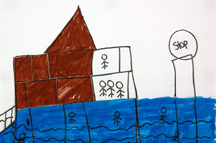|
Renaissance Village Art Therapy Trip #7– May
2007
Almost two years after the devastation of Katrina
much of our nation believes that the situation in Louisiana has
improved and people have put their lives back together. Unfortunately,
returning on our seventh visit to Renaissance Village, this is
not what we found. There are approximately 1700 people still living
in these camper trailers. These trailers were never meant to be
homes. The feelings of hopelessness, frustration, anger and loss
filled the camp. Lack of transportation, jobs, schooling, money
and choices continued to be major problems. There were mounting
physical and mental health issues. We learned that three families
moved out of the trailer park to better situations only to have
these now empty trailers immediately filled with displaced people
trying to move closer to New Orleans. Added to this growing list
of problems were the molding trailers, and the returning hurricane
season. Many call this displaced
population, The Forgotten People.
A core group of eleven art therapists and volunteers
returned to the trailer facility after an eight-month absence.
We were joined daily by Sister Judith who was warmly greeted not
only for her help and love but also for the delivery of lunches.
This trip was made possible by a generous donation from AEG, one
of the world’s
leading sports and entertainment presenters, and others. The majority
of the core team had volunteered their time. Through the Romcyn Atelier
Foundation, Wayne State University in Nebraska funded two of the
team members. Two art therapy students from Emporia State University
in Kansas supplied their own funding. Local mental health workers
and volunteers joined us for on-site training sessions and art
therapy work.
We had two main goals this trip. Our first goal was
to continue our art therapy work.
 |
 |
| The art was used
for many different reasons. The art allowed many of the children
to focus, settle and feel good about themselves. They were
able to draw somewhat stable and solid structures unlike the
pictures they drew during our earlier trips. |
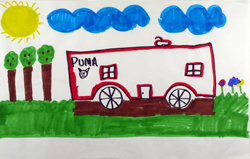 |
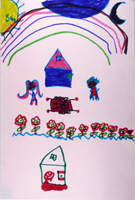 |
Some
used it to process the overwhelming feelings they experience
while living in this difficult situation. |
| |
|
| |
|
| We used the art as an assessment
tool. A few pictures continued to show how the trauma of Katrina
was still a major part of their psyche. |
| |
|
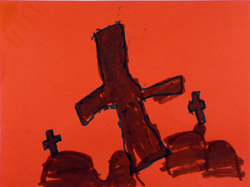 |
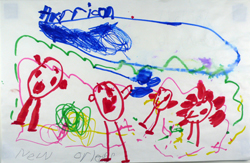 |
| |
|
| Others were able to create
something out of cast off items and internalize the process
of making something beautiful out of throw-away materials. |
| |
|
|
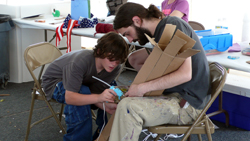 |
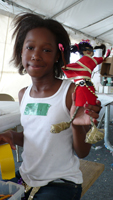 |
 |
| |
|
| |
|
| While creating art in the
large tent we also offered safety, food, role modeling, and
hope. In return we received the privilege of connecting
and creating art with many wonderful survivors. |
 |
| |
|
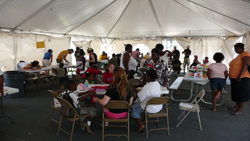 |
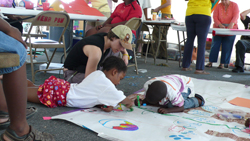 |
| |
|
| |
|
The second goal
for this trip was to generate interest and commitment from
local personnel to develop an on going art program for the
children. We provided classroom-training sessions for approximately
twenty interested mental health workers and volunteers after
which, they joined us in the large tent to work one-on-one
with the children. There is a plan in action to create
an on going art program. Many of these individuals will join
us to work on our next trip and we will continue to train interested
local people.
It was interesting to watch the team work this
trip. It was apparent that during the first few days the feelings
generated by this hopeless, depressed and frustrated population
had affected our work. It all seemed so heavy and difficult.
We had begun to reflect the feelings of the people we were
trying to help. Once this was identified, processed and a new
plan of action was put in place, the work changed. We initiated
the difference by creating silly, fun hats. This also became
a cultural activity for the survivors of New Orleans. We
all wore the hats and had the teens take photos. |
| |
|
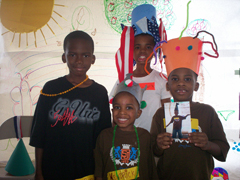 |
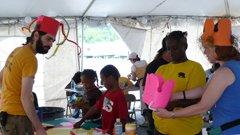 |
| |
|
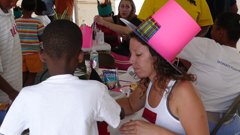 |
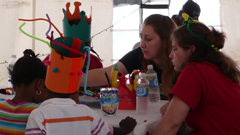 |
| |
|
| |
|
| The teenagers
are overcome with boredom, anger and isolation. The opportunities
to get in trouble are many. Unlike most other teens with choices,
these teens lack things to do, places to go and transportation
to get there. Initially we had difficulty getting many
of the teens we had worked with in the past to participate.
They appeared angry, agitated, depressed and frustrated. We
were finally able to engage even the toughest teens, with the
belief that even the troublemakers were good kids, through
a persistent focus and the use of photography. They were given
digital cameras to take self-portraits, photos of peers and
things important to them. Almost every teen took their
self-portrait with a painted poster of New Orleans. Using
the camera allowed these teens to create and imagine a piece
of their own history and validate their identity. It also allowed
them to process their losses. |
| |
|
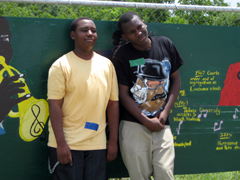 |
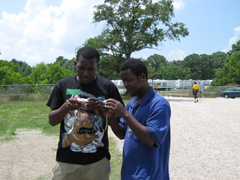 |
| |
|
| |
|
Throughout the remainder
of the week the teens continued to participate with the others
while building sculptures from recycled materials. While working
with one quiet and bright teenage girl she told me it was extremely
difficult to live there. She seldom left her trailer
except to go to school. She thanked me for being there
and told me that it felt good to have a place to go, to create
something she felt good about and to feel safe.
It is amazing to think that we have had a relationship
with many of these families for two years. We have watched
them grow and change. There is a big difference between a four
year old and a six year old. One young boy reminded me that
he was no longer the baby he was at four now that he was a
big six. It is hard to imagine what the future brings for these
children unless some major changes take place. Changes in mental
health, education, transportation and the way the nation views
our poor and displaced. For the displaced families at Renaissance
Village we have begun to make a small change by offering mental
health service through art therapy.
One young boy knows that he is not forgotten.
He said that he knew he was loved. When asked how he knew that
he replied, “I know you love me because you keep on coming
back.” |
| |
|
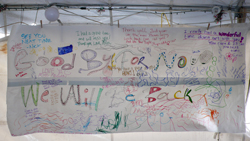 |
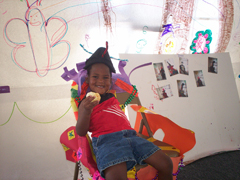 |
Katrina Through the Eyes of Children, the mixed media art exhibit created by these children becomes more important with every visit. This story must be told!
<< Return to Project Background Home
|


